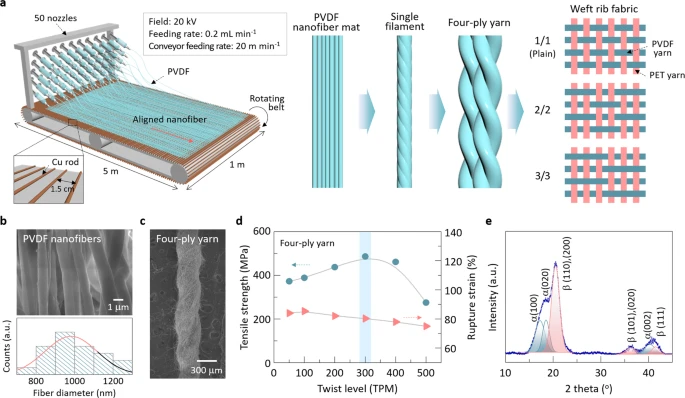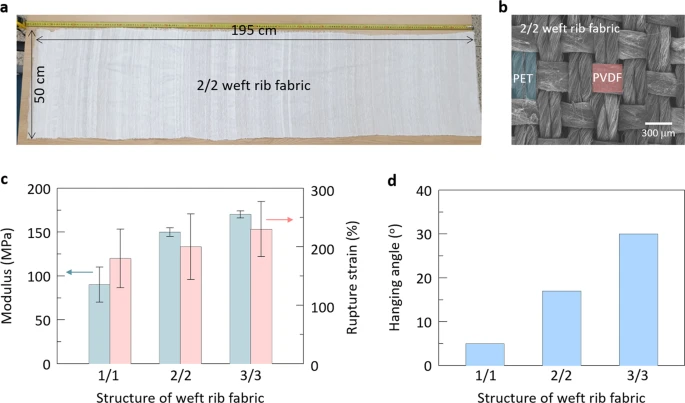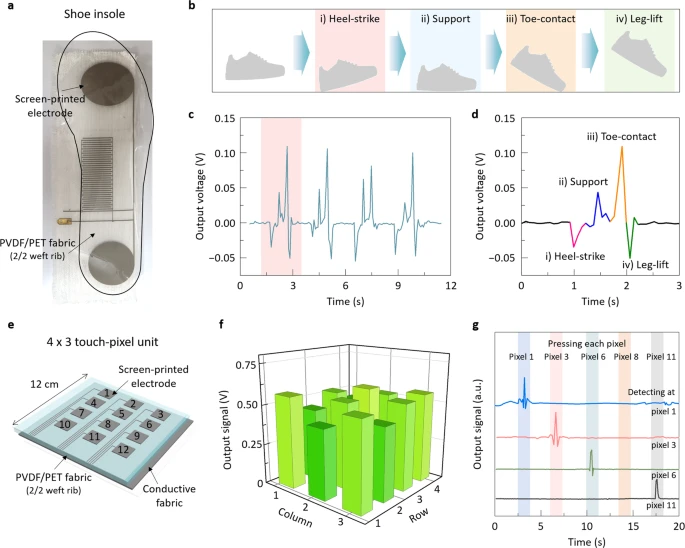Wearable pressure sensors can help monitor human health and realize human-machine interaction. Continuous efforts are being made to achieve pressure sensors with versatility in device structures and high sensitivity under the mechanical stimulus.

Study: Weave-pattern-dependent fabric piezoelectric pressure sensors based on polyvinylidene fluoride nanofibers electrospun with 50 nozzles. Image Credit: Africa Studio/Shutterstock.com
An article published in the journal npj Flexible Electronics reported the fabrication of fabric piezoelectric pressure sensors using polyethylene terephthalate (PET) warp yarns and poly(vinylidene fluoride) (PVDF) weft. The weave pattern-based pressure-sensing performance of the developed pressure sensors was demonstrated using a fabric scale of approximately 2 meters.
The results revealed that pressure sensors optimized with a 2/2 weft rib pattern had 245% higher sensitivity than in a 1/1 pattern. Moreover, various input sources, including bending, pressing, crumpling, twisting, and various human motions, were applied to evaluate the performance of the optimized fabric. In this work, fabric-based pressure sensors with arrayed touch pixel units demonstrated stable sensing performance with high sensitivity.

Figure 1. Preparation of PVDF yarns and versatile woven fabrics. a Schematic of the 50 nozzle electrospinning process for producing an aligned PVDF nanofiber mat, wherein the Cu rods are positioned in parallel on the conveyor belt, with the steps for preparing three woven structures from four-ply yarns made from a single filament. b SEM image of the aligned as-prepared PVDF fibers with the fiber diameter distribution. c SEM image of a four-play yarn. d Tensile strength and rupture strain of the four-ply yarn as a function of the twist level. e XRD pattern of the four-ply yarn, indicating the presence of α- and β-phases. © Kim, D. B., Han, J., Sung, S. M., Kim, M. S., Choi, B. K., Park, S. J., Hong, H. R et al. (2022)
Piezoelectric Pressure Sensors
The rapid growth of intelligent robots and wearable electronic devices led to various new-type devices based on flexible pressure sensors, with high-speed development for their applications in electronics, industries, and health care fields.
Piezoelectricity is the charge created across materials subjected to mechanical stress. Piezoelectricity in asymmetric materials allows a linear, reversible relationship between mechanical stress and electrical charge. Thus, when a piece of piezoelectric material undergoes physical deformation, the electric charge is generated and vice-versa.
Piezoelectric devices can utilize a free mechanical source, providing an energy alternative for electronic components that consume low power. Type of materials and device structure are critical parameters in producing electromechanical coupling-based sensing devices. In addition to high piezoelectric inorganic materials, organic materials with mechanical flexibility were also explored in wearable devices.
Polymers, in the form of nanofibers processed by the electrospinning method, are used on a large scale as piezoelectric energy harvesters. Piezoelectric polymer nanofibers help create a fabric-based devise structure for wearable applications, ensuring mechanical resilience-based electromechanical power generation under various environments.
To this end, piezoelectric polymers, including PVDF and its derivatives, are widely available and have strong piezoelectricity. These PVDF fibers were processed into fabric through drawing and twisting into yarn for piezoelectric applications, including sensors and generators.

Figure 2. Large-area fabric and their physical characteristics. a Photograph of the large-scale woven fabric with the 2/2 weft rib pattern, reaching dimensions of 195 cm × 50 cm. b SEM image of the 2/2 weft rib pattern consisting of alternately crossing a single strand of PVDF weft yarn with two strands of PET warp yarn. c Modulus and rupture strain of different woven fabrics of 1/1, 2/2, and 3/3 weft rib patterns. d Hanging angles measured for the fabrics. © Kim, D. B., Han, J., Sung, S. M., Kim, M. S., Choi, B. K., Park, S. J., Hong, H. R et al. (2022)
Weave-Pattern-Dependent Fabric Piezoelectric Pressure Sensors
In the present work, a PVDF nanofiber yarn-based fabric generator was constructed in a sequential process with 50-nozzle-electrospinning, where the use of 50 nozzles helped produce a nanofiber mat using a conveyor with a rotating belt. Different weave structures, including 1/1 (plain), 2/2, and 3/3 weft rib patterns, were created using PET yarns.
Previous work reported the use of copper for fiber alignment in the form of arrayed copper wires on a drum of fiber collectors. However, the present work includes parallel copper rods aligned on the conveyer belt with an interval of 1.5 centimeters that helped align the spun fibers based on the electrostatic interactions between incoming charged fiber and the charge on the fiber surface attached to the copper.
Unlike previously reported capacitive or piezoresistive sensors, the proposed fabric pressure sensors in the present work responded to a broad range of input forces from 0.02 to 694 newtons. In addition, the proposed fabric pressure sensors retained 81.3% of initial input after the standard wash for five-time, indicating the durability of the pressure sensors.
Moreover, evaluating sensitivity values for the voltage and current outcomes of the weaved 1/1, 2/2, and 3/3 weft rib patterns revealed a high voltage sensitivity of 83 and 36 millivolts per newton for 2/2 and 3/3 weft rib pressure sensors, respectively, confirming a 245% and 50% enhanced sensitivity of these pressure sensors compared to 24- millivolts per newton for 1/1 weft rib pressure sensors.

Figure 3. Extended applications of all-fabric pressure sensors. a Example of a shoe-insole pressure sensor fabricated from the 2/2 weft rib fabric, which was inserted below two circular electrodes to detect the front (just below the toes) and heel motions. b Schematic illustrations of each stage of a single step during walking: heel-strike, support, toe-contact, and leg-lift. c Output voltage signals in response to each part of a walking step for gait analysis, and d the magnified electrical signals correlated with each stage in a step. e Schematic of all-fabric pressure sensors with an array of box-type pixel units numbered up to 12, with the conductor lines patterned for detecting separate signal from each pixel. f Three-dimensional plots of electrical signals produced by finger-pressing of each pixel. g Electrical signals detected only at the pixel pressed by finger, without the creation of side-signals at other pixels, confirming no cross-talk. © Kim, D. B., Han, J., Sung, S. M., Kim, M. S., Choi, B. K., Park, S. J., Hong, H. R et al. (2022)
Conclusion
In conclusion, highly sensitive and wearable fabric-based pressure sensors incorporated with piezoelectric PVDF nanofiber yarn were demonstrated in this study. The fabricated pressure sensors had a wide range of input forces of 0.02 to 694 newtons.
Fifty nozzles were used on a single prototype electrospinner, and a continuous nanofiber mat was produced using an intermittent copper rod-based conveyer. Under periodic compression, the as-prepared fabric with a 2/2 weft rib pattern showed a sensitivity of 83 millivolts per newton, which was approximately 245% higher than the 1/1 weft rib case.
The proposed all-fabric pressure sensors were monitored for electrical signals by subjecting them to physiological motions, including twisting, bending, crumpling, running, and walking. Additionally, these fabric pressure sensors were comparable to regular cloth in terms of durability, retaining about 81.3% of initial output even after five standard washes. Moreover, the prepared fabric sensor was effective in health systems for generating electric signals based on sequential human walking segments.
Reference
Kim, D. B., Han, J., Sung, S. M., Kim, M. S., Choi, B. K., Park, S. J., Hong, H. R et al. (2022). Weave-pattern-dependent fabric piezoelectric pressure sensors based on polyvinylidene fluoride nanofibers electrospun with 50 nozzles. npj Flexible Electronics. https://www.nature.com/articles/s41528-022-00203-6.
Disclaimer: The views expressed here are those of the author expressed in their private capacity and do not necessarily represent the views of AZoM.com Limited T/A AZoNetwork the owner and operator of this website. This disclaimer forms part of the Terms and conditions of use of this website.